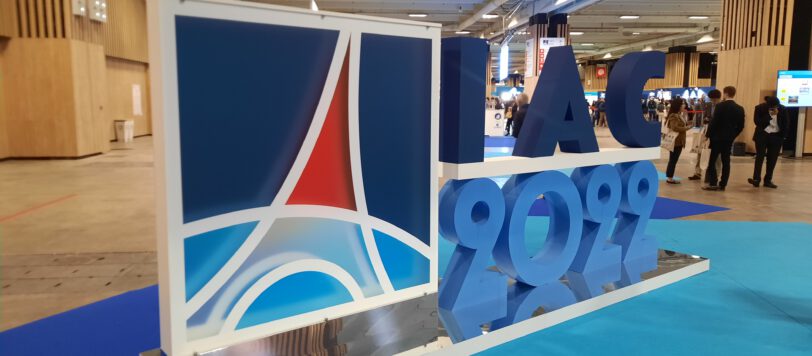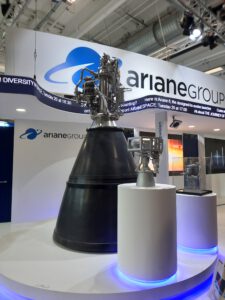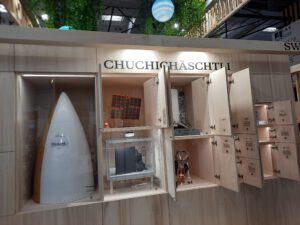Categories: Training
Tags: conference CPD IAC International Astronautical Congress
Posted by: Amelie Aichinger
Cosmic Lingua at IAC 2022 in Paris

Cosmic Lingua attends its first major space event
I (Amelie Aichinger, founder and head of Cosmic Lingua) had already attended a few space events in the past (such as the UK Space Conferences 2019 and 2021 or the digital DLRK of 2021), but the IAC 2022 in Paris was the first in-person event I signed up for since I founded Cosmic Lingua in 2021.
It turned out to be the biggest IAC to date: with over 4,800 abstracts from more than 97 countries, over 9,000 registered attendees and approximately 250 exhibitors, it was a record-breaking conference and a great opportunity for both learning and networking.
A one-of-a-kind experience
Sunday: overcoming overwhelm
The congress opened on Sunday, 18th September, in an impressive auditorium with fantastic lighting and stage set-up, inspiring speeches and a breakdance show by the French national team.
For me, this day was all about taking everything in: finding my way around the large venue, mapping out the exhibition hall and planning and attending the first set of technical sessions.
The session I picked was about habitats and space architecture, a very varied and interesting area to explore. The topics of the papers presented ranged from the similar challenges space and underwater habitats pose to a potential architecture of a Moon village. My personal highlights of the session were the following:
- the ISS archaeological project, which explored how astronauts on the ISS use their space and personalise it (find out more about his topic on their website)
- a paper on the accessibility of space for everyone by AstroAccess, an organisation conducting research into areas such as whether or not sign language works in microgravity; this could have a vital impact on emergency procedures for events, where astronauts are deafened, for example (find out more about their activities here)

Monday: learning
After a quick morning trip to Père Lachaise cemetery (as one of the very few tourist attractions in Paris that open at 8am), my second day at the conference was very much focused on technical learning, both in the sessions I attended (commercial spaceflight safety and emerging issues and medical care for humans in space) as well as on the exhibition floor, chatting to representatives of Arianespace, Isar Aerospace, ZeroG, and many more.
Here are a few personal highlights of the second day:
- the Space Generation plenary with a very diverse panel discussing the use (and potential over-use) of AI in space
- interoperable data exchange for suborbital intercontinental travel, based on existing air traffic control concepts
- a lawyer presenting a paper asking the question of who is liable for injuries in space and highlighting gaps in existing law—especially important now at the dawn of space tourism

Tuesday: networking
Since there was no clear-cut choice for me which technical session to attend in the morning, I decided to spend it working the exhibition floor. I ended up having great chats with all kinds of people: from government agency representatives to employees of the big primaries to enthusiastic members of start-ups. And they were not only of a technical nature, but also touched on subjects like space tourism and media and outreach—a great representation of the many facets of the industry, I felt.
By pure luck, I also ended up catching some of the interesting talks happening at individual booths. A stand-out one for me was a presentation organised by ESA, focused on intercultural and collective leadership.
The opening of the afternoon of day three was a plenary on planetary defence, discussing (among others) NASA’s DART mission, which impacted asteroid “moon” Dimorphos and successfully changed its orbit around its parent asteroid on 26th October, only a few days after the congress closed.
After this riveting panel (including Bill Nye, by the way!), I headed over to the technical session on medical care in extreme environments. This session was again very varied, covering topics from semi-autonomous medical treatment drones/rovers to neuroscience and the impact of gravity on bone healing.

Wednesday: an event cut short
Unfortunately, Wednesday was my last day at the IAC. It started out great with a breakfast event, where four panellists had a very open and honest discussion about personal failure; followed by a plenary on James Webb Telescope, its development, its science goals and its fantastic potential for public outreach.
The technical session I had picked for this morning focused on exactly that too—outreach to the general public. My personal highlights included:
- SelfieSat, a satellite project by Norwegian students, aiming at getting more students interested in space
- a paper looking into the question how increased space literacy of a nation might lead to more scepticism and less enthusiasm towards advances in the sector
- the presentation of a Turkish space outreach centre, offering hands-on experiences and experiments to engage young audiences
The very last event I was able to attend before having to make my way back to the train station was the JWST media event with the reveal of a new (infrared) image of Neptune. One of the most exciting sessions I was able to take part in during the congress.
That was, however, where my first IAC ended. I regretted being unable to stay for day five, especially since it included a technical session on multilingual astronautical terminology. The perfect crossover of topics for a space translator!
Personal take-aways
One of the things that I really liked about this year’s IAC was its focus on sustainability: everyone received a reusable water bottle to reduce the consumption of plastic bottles and paper cups, there were no physical printed programmes and attendees were asked to recycle where possible.
Another thing that really struck me was the friendly and very international atmosphere—but the type of international feeling that does not lose touch with its original identity. A prime example of this was the Swiss space agency’s booth, which sported the word “Chuchichäschtli” on its outside, often used as a typical example for Swiss German words.
Overall, it was a very positive experience; I had great chats with all kinds of people, everyone was very friendly and enthusiastic. I am already looking forward to my next IAC, which will most likely be IAC 2024 in Milan!



Comments are closed.